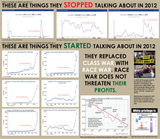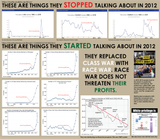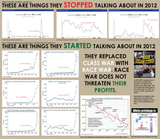>>215712519
Divisive propaganda pumped up after OWS that broke people's brains. We are still living with the fallout from the division psyop.
4chan Search
12 results for "4bd9b991eeb30f5660f96ae19c1737cc"
Before 2008 the cultural propaganda focused on tolerance. After 2008 we were closed to revolution so the propaganda shifted to keep the plebs at each other's throats. All the woke shit now was a psyop to keep the lower classes from looking up.
>>519048356
no
no
Race war doesn't threaten profits.
Timeline: Post-2012 Survival of the Financial Elite
2012–2013: Suppression and Fragmentation of Occupy
Police crackdowns dismantled Occupy encampments in late 2011–2012.
The movement lacked centralized leadership or concrete demands, making it easier to disperse.
Wall Street largely weathered the storm with no major reforms to banking power.
Result: Class anger was real, but not institutionalized.
2013–2014: Shift in Media & Cultural Discourse
Media coverage of bankers, bailouts, inequality dropped sharply (as shown in your image).
Coverage of race, identity, and culture war topics increased, coinciding with events like Trayvon Martin (2013) and Ferguson (2014).
Elites and corporations began sponsoring identity-based campaigns (e.g., diversity initiatives, branding around social justice).
Class critique was sidelined; identity became the dominant lens.
2014–2016: Return of Financial Power
Dodd–Frank reforms (passed in 2010) were already being watered down by lobbying.
Too-big-to-fail banks grew even larger due to consolidation.
Stock markets surged with quantitative easing and low interest rates, massively enriching asset holders.
Private equity and hedge funds expanded into housing, buying foreclosed homes and creating today’s rental crisis.
Finance reasserted dominance, with public anger dissipated.
Police crackdowns dismantled Occupy encampments in late 2011–2012.
The movement lacked centralized leadership or concrete demands, making it easier to disperse.
Wall Street largely weathered the storm with no major reforms to banking power.
Result: Class anger was real, but not institutionalized.
2013–2014: Shift in Media & Cultural Discourse
Media coverage of bankers, bailouts, inequality dropped sharply (as shown in your image).
Coverage of race, identity, and culture war topics increased, coinciding with events like Trayvon Martin (2013) and Ferguson (2014).
Elites and corporations began sponsoring identity-based campaigns (e.g., diversity initiatives, branding around social justice).
Class critique was sidelined; identity became the dominant lens.
2014–2016: Return of Financial Power
Dodd–Frank reforms (passed in 2010) were already being watered down by lobbying.
Too-big-to-fail banks grew even larger due to consolidation.
Stock markets surged with quantitative easing and low interest rates, massively enriching asset holders.
Private equity and hedge funds expanded into housing, buying foreclosed homes and creating today’s rental crisis.
Finance reasserted dominance, with public anger dissipated.
>>513884761
>Just give them a culture war to be angry about instead of actual politics?
Liberals too. They've spent the last decade and a half kvetching about faggots and blacks while the working class got poorer and poorer.
>Just give them a culture war to be angry about instead of actual politics?
Liberals too. They've spent the last decade and a half kvetching about faggots and blacks while the working class got poorer and poorer.
>>513223248
Racism is not systemic. A very small, tiny, miniscule minority are actually racist, and even less of those actually behave in any way that would affect someone else because of it. But the big ((bankers)) got afraid when people realized they were the real enemy and started using the ((media)) to raise a generation of kids to think that racism is a problem. picrelated
Racism is not systemic. A very small, tiny, miniscule minority are actually racist, and even less of those actually behave in any way that would affect someone else because of it. But the big ((bankers)) got afraid when people realized they were the real enemy and started using the ((media)) to raise a generation of kids to think that racism is a problem. picrelated
It's actually all downstream of OWS.
>>713447219
today I'll remind them
today I'll remind them
>>508283630
I was there for this until the left refused to tell the truth then dived headfirst into wokeism. You lied then and you're lying now.
I was there for this until the left refused to tell the truth then dived headfirst into wokeism. You lied then and you're lying now.







